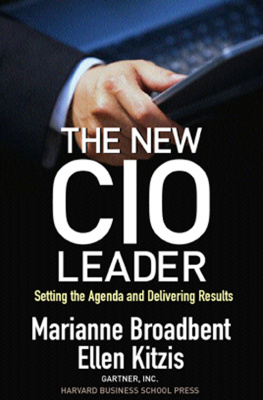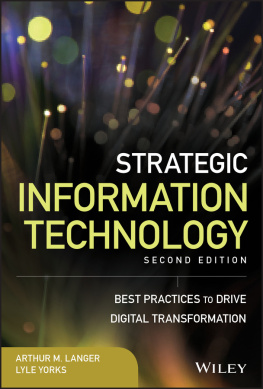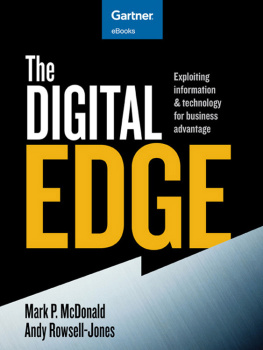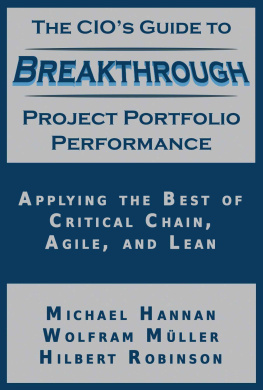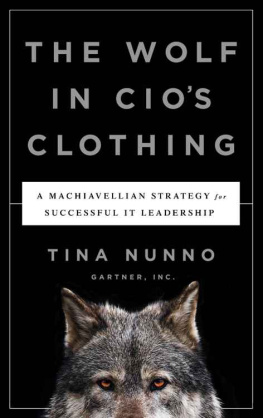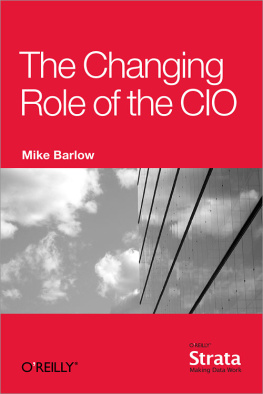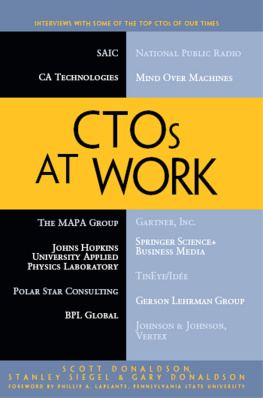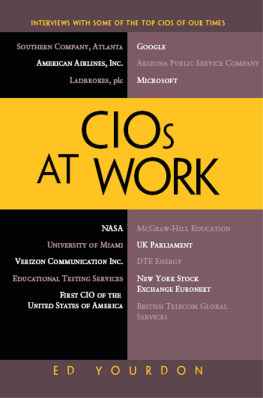Copyright 2005 by Gartner, Inc.
All rights reserved
No part of this publication may be reproduced, stored in, or introduced into a retrieval system or transmitted, in any form, or by any means (electronic, mechanical, photocopying, recording, or otherwise), without the prior permission of the publisher. Requests for permission should be directed to , or mailed to Permissions, Harvard Business School Publishing, 60 Harvard Way, Boston, Massachusetts 02163.
First eBook Edition: December 2004
ISBN: 978-1-5913-9577-5
For all the CIOs
weve worked with
over many years
For helping us get the research done
First, we thank the hundreds of executives who have worked with us over many yearsespecially CIOs, their executive colleagues, and their teams. All these people have taken us into their confidence, sharing their achievements, their challenges, and their frustrations and worked with us by challenging our thinking and by implementing our suggestionsin essence, testing our ideas into reality. Many are named in the pages of this book, but many more are not named. We particularly thank Paul Coby (British Airways), Joe Locandro (Yallourn Energy), and Tom Sanzone (Citigroup Global Transaction Services) for working with us on extended case examples.
Second, The New CIO Leader draws on the work of many people, especially that of our Gartner colleagues as well as some business-school thought leaders and authors.
For just about every month since the late 1990s, Gartner Executive Programs (Gartner EXP, a membership-based organization of more than two thousand CIOs worldwide) has released a report prepared exclusively for its members. This work has been led by members of Gartners CIO research team who work closely with program delivery teams from across the globe. This book has drawn on those reports, as well as the thinking and the case examples that went into themor in some cases the examples that did not go into them! On the research side, we thank particularly Mark McDonald, Dave Aron, Dr. Marcus Blosch, Jeannette Kieruj, Patrick Meehan, Andrew Rowsell-Jones, Richard Hunter, Chuck Tucker, Roger Woolfe, and adjunct researcher Barbara McNurlin. On the program delivery side, we thank regional leaders Nick Kirkland (EMEA) and Jos Ruggero (AsiaPacific) and the many program team members who assisted us in working with CIOs they partner with and who alerted us to additional new CIO leaders.
In the area of managing by maxims, this book extends and updates work Marianne previously completed with our good friend and colleague Professor Peter Weill, from the Sloan School of Management at MIT. Peter Weills groundbreaking work on IT governance at MIT in 2002 stimulated extensive research with Gartner EXP members.
We thank other thought and practice leaders who have variously coauthored EXP reports, provided substantial input at EXP member forums and symposia, or shared with us their perspective. These include Professor David Feeny (Said Business School, Oxford University), Peter Keen, Don Laurie, Professor John Henderson (Boston University), Bruce Rogow, Dr. Jeanne Ross (MIT Sloan School of Management), Dr. Jeff Sampler (previously London Business School, now Templeton College, University of Oxford), Dr. Mani Subramani (Carlson School of Management, University of Minnesota), and Professor Mike Vitale (AGSM, Sydney).
Among many Gartner research analysts and consultants, we particularly thank Audrey Apfel, Jackie Fenn, David Flint, Chris Ganly, Rob Gout, Mike Gerrard, Bob Hayward, Nick Jones, Andy Kyte, Al Lill, John Mahoney, Ken McGee, Simon Mingay, Diane Morello, Daryl Plummer, John Roberts, and Michael Smart.
For helping us give birth to the book
Although the idea for this book was in our heads and hearts for some time, it was the experience of creating Gartners first CIO Academy in 2002 and then leading it many times that really illustrated the possibilities and need for this book. At the Academies, we saw that new CIO leaders were out there, that many wanted a guide on how to be a great CIO, and that we could help them. The hardworking Diana Cirillo deserves special mention as CIO Academy coordinator for extraordinary efforts in the Academys birth.
On both a professional and a personal level, we especially thank Robin Kranich, Gartners very gutsy Senior Vice President for Executive Programs, whose roles variously as a friend, colleague, boss, encourager, and advocate resulted in a very stimulating and rewarding work environment. Her complete support and enthusiasm for The New CIO Leader made our jobs much easier.
The work of a number of key professionals then nurtured the passage of the book. Heather Levy and Tim Ogden, Gartner Presss publisher and editor, respectively, worked with agent Susan Barry and Harvard Business School Press editor Jacque Murphy on the scope of the book. The very patient and focused Kent Lineback helped us find the right focus and tone. Kent worked with us on identifying our key messages among literally hundreds of thousands of words we already had available to us. Tim Ogden did an amazing job as editor for Gartner Press, constantly challenging us about what was really important. Then Jacque Murphy came into the picture, again poking and prodding the manuscript to make sure our thoughts and words flowed as well as they could. We believe that Jacques keen feel for structure and flow has made it considerably easier to pick up our messages.
For helping us to get on with doing what we do
Each of our lives required quite a bit of coordinationespecially since this book was written while we were trying to just get stuff done. To that, we owe a big debt to the duo of Tim Ogden and Kent Lineback, who worked with us to form a very harmonious and productive quartet. But other people helped hold things together or took on extra loads at critical times. For Marianne, this support came from members of the EXP research team, especially the calm, organized, and truly dedicated Jeannette Kieruj, who was then our team coordinator. For Ellen, this support came from Brendan Conway, Mark Deacon, Chris Goodhue, Ione deAlameida Coco, and Judy Perugini, who gave extra of themselves so that she could focus on the book, knowing that our EXP members and team would be well looked after.
Finally, we each want to thank our husbands and families and close friends for understanding and accepting the kinds of things we like to do. The opportunity to work with executives in many parts of the world means that youre away from home quite a bit, that your family becomes adept at self-help, that your calendar always has to be consulted, and that your husband has to answer the often-asked question, So, where is she now? We know that Robert Broadbent and Larry Stevens are pretty special peopleat least everyone else tells us they are, and we have to agree. Thanks, guys, for always being willing to explain to the kids, the grandkids, or the cat where she is now, even if sometimes you are not too sure. It is hugely appreciated.
Introduction:
The Crossroads
Two paths diverged in a wood
and I took the one less traveled.
ROBERT FROST
Chief information officers today stand at a crossroads. The role of each CIO is inevitably changing, because of two perspectives on information technology (IT). On the one hand, there is the lingering disaffection with IT from the Internet bust, the overexpenditure on technology capacity, the popular presss assertion that IT is now irrelevant in discussions of competitive advantage, and the hysteria about IT jobs moving overseas. On the other hand, IT is gaining renewed interest for several reasons. The global economy seems to be finally escaping the doldrums, and business executives are desperate for innovation. Additionally, the regulatory environment has put far more emphasis on the timeliness, completeness, and accuracy of corporate information. Finally, technology is playing a foundational, if not a central, role in virtually every product and service.

